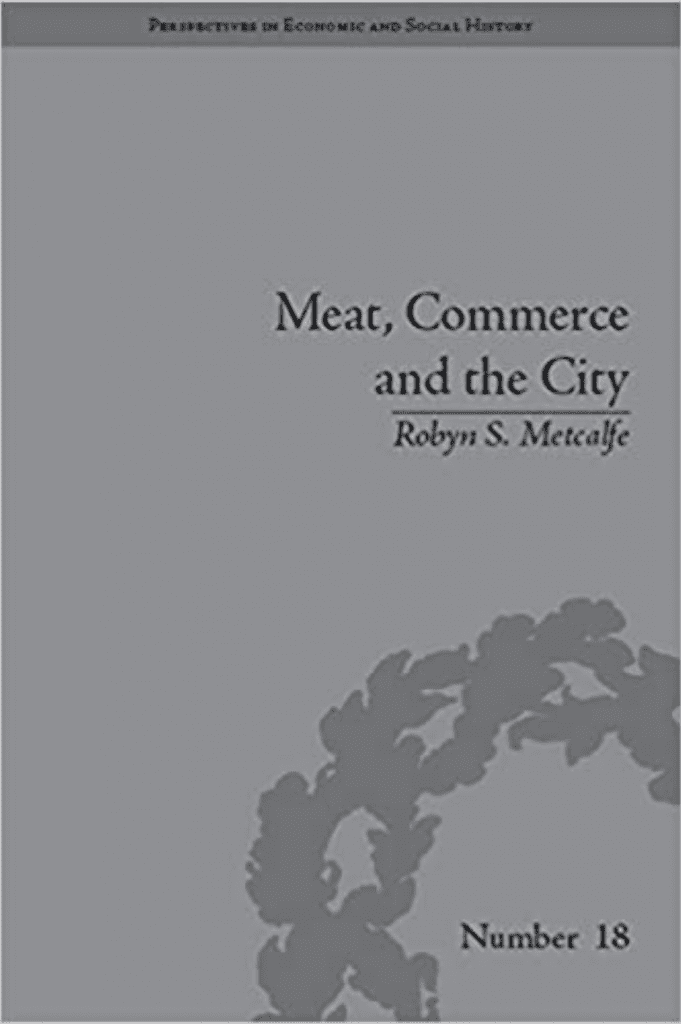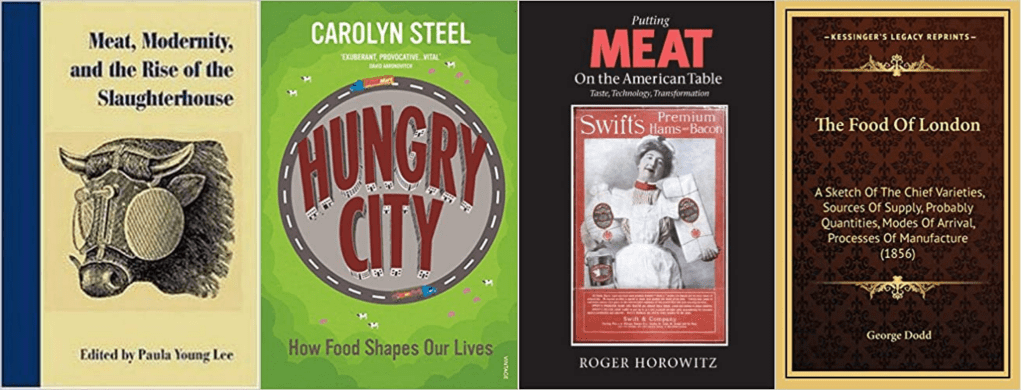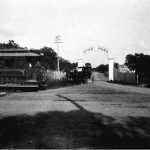By Robyn Metcalfe
For at least a century, food markets have been disappearing from our urban landscapes. Beginning in the early 19th century, cities began to uproot food markets and place them in the suburbs or even further away. It has only been within the last two decades that fresh food is reappearing in the form of farmers markets. Why was food removed from the cities in the first place?
The story of the removal of the Smithfield live cattle market suggests an answer to that question. In 1855, London’s live cattle market, the world’s largest meat market, closed and moved to Islington, a suburb of the City. It took fifty years of arguing in Parliament before a bill was passed to remove the cattle market. Surely, an investigation of why it took so long would illustrate how cities modernized in the nineteenth century.
Food markets, the heart and soul, if not stomach, of urban centers were central and visible representations of urban communities. Throughout history, cities appeared as provisioning entrepôts, often located near transportation networks such as rivers and oceans. London, first to experience an industrial revolution, was also first to reconsider how its food markets fit into a new, modern conception of urban identity. The removal of London’s live cattle market heralded similar relocations of food markets in other cites, such as Paris, New York, Boston, and Chicago. These cities reacted to the industrialization and modernization of their food markets in ways consistent with their own urban culture.
The transformation of urban space also reflected a change in the way city dwellers viewed food. Since the Middle Ages, Smithfield had been a fluid space with few sharp angles and corners, nestled at the terminus of a network of cattle droving roads. With the arrival of the reform era and utilitarianism, urban spaces became rationalized, straightened, covered, and controlled. When the live cattle market moved out of Smithfield, meat moved away from consumers, removing the sights, smells, and connection between production and consumption. Urban wholesale markets moved outside the metropolis, repurposing rural space and connecting the City to the countryside as railroads enabled more meat to be slaughtered outside London and transported to the City by railway. In similar ways, these new transport networks and markets enlarged London’s role in a global and imperial food system. These connections situated the London meat market in a larger context of global trade.

Also by mid-nineteenth century, London had experienced industrialization, doubling in size and increasing in economic prosperity. The city suffered two cholera epidemics and gained a new appreciation for the fragility of public health and the fatal consequences of filth for a crowded urban population. The public was more informed with increasing literacy and number of publications that described urban problems and potential solutions. The reform era (1820s-1840s) compelled London’s inhabitants to address urban blight, corruption, sanitation, and environment. Utilitarianism sent improvers into the streets to find rational means for reorganizing streets and urban space. Railroads sliced into London’s corpus, connecting the metropolis in new ways to the countryside and other continents. Individuals with a new sentimentality and sensitivity towards nature joined groups such as the Society for the Prevention of Cruelty to Animals. Restrictions on the British economy were loosened, bringing foreign livestock into the market, drawing upon concerns about government regulation. London’s markets were becoming free of the old system governed by guilds and entrepreneurs found business opportunities within an expanding consumer market. Retail specialists appeared on London’s streets as covered modern market spaces took the place of the old market fields. During the nineteenth century, industrialization provoked new technologies, increased demand by an expanding middle class, and tore up the landscape with new streets and railroads. By 1850, London was ready for a more rational and mechanized provisioning system.
A walk through the Smithfield Central Markets today offers visual reminders of Smithfield’s history as the site of Britain’s largest live cattle market during the Victorian period. Located in West Smithfield in the City of London, the Central Markets contain the wholesale meat trade for London. The markets, opened in 1868, settled into the space previously occupied by the live cattle market in 1855. Today the Central Markets teem with wholesale customers, porters, and meat salesmen from ten at night until late morning the following day. The meat business still permeates the area around the Smithfield Central Markets. Street names telegraph Smithfield’s past: Skinner’s Lane, Giltspur (from its history as a venue for knights and their tournaments), and Cow Cross Lane.
The struggle for a meat market in Smithfield continues. In 2004, SAVE, a London-based building conservation organization announced a campaign called, “Don’t Butcher Smithfield” to resist development of the Smithfield General Market Buildings. The City had an elaborate plan to replace the Victorian buildings of the Smithfield Live Cattle Market designed by Horace Jones with an office block. The campaigns of SAVE and English Heritage were successful and in August, 2008, the Secretary of State for Local Government and Communities denied the City the right to redevelop the General Market Building. But in 2012, property developers submitted another plan for new office and retail space in the historic market. It is unclear how long the old Victorian market will last in the heart of London’s historic Smithfield.

Roger Horowitz, Putting Meat on the American Table: Taste, Technology, Transformation, (2005).
Horowitz describes a history of the relationship of meat and consumers that is similar to the European experience.
Paula Young Lee, ed. Meat, Modernity, and the Rise of the Slaughterhouse, (2008).
An edited selection of essays that address issues related to meat in our cities. Meat markets heighten concerns about sanitation and animal welfare.
George Dodd, The Food of London, (1856, Reprinted 2010).
A detailed description of London’s food system through the eyes of a 19th-century journalist and surveyor.
Carolyn Steel, Hungry City: How Food Shapes Our Lives, (2009)
A British architect describes how cities and food markets have evolved throughout history.
Related Links:
Photo Credits
London Illustrated News, June 16, 1856
Robyn Metcalfe, video
London Meat Market by Jorge Royan, via Wikimedia



